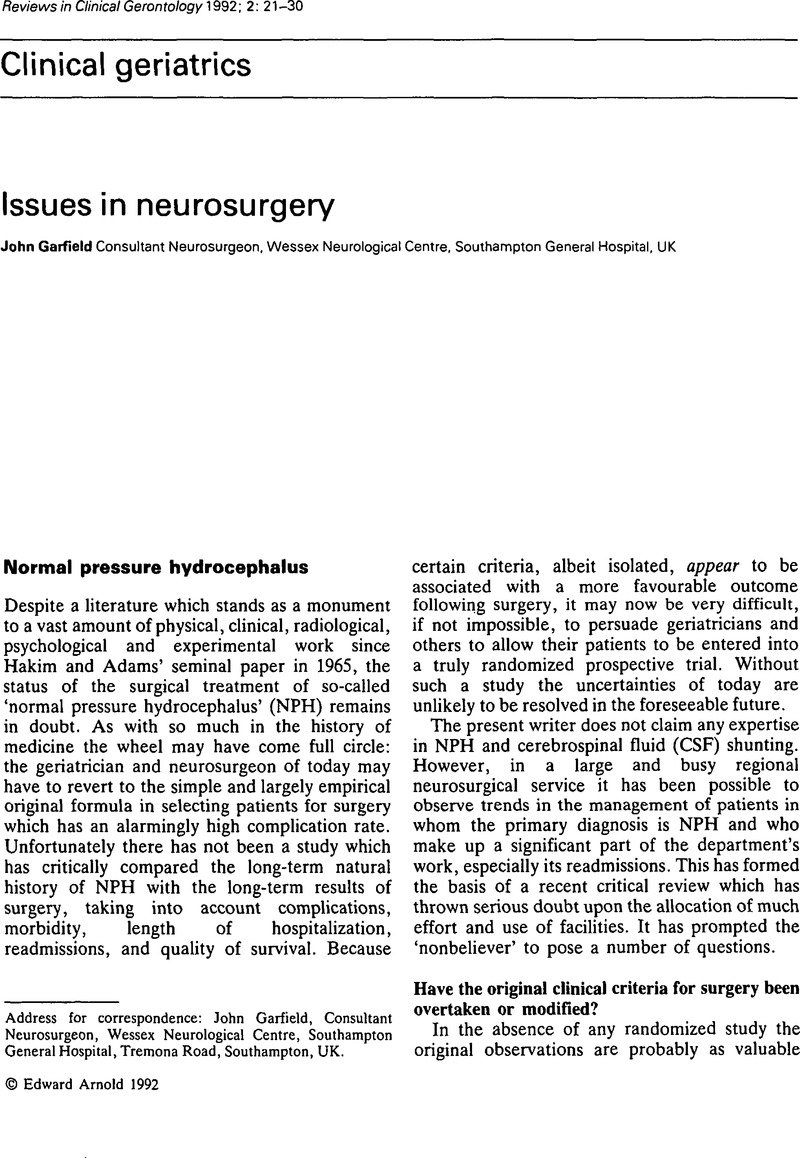No CrossRef data available.
Article contents
Issues in neurosurgery
Published online by Cambridge University Press: 17 November 2008
Abstract
An abstract is not available for this content so a preview has been provided. Please use the Get access link above for information on how to access this content.

- Type
- Clinical geriatrics
- Information
- Copyright
- Copyright © Cambridge University Press 1992
References
Further reading
Borgesen, S.Fleming, G.Relationships between intracranial pressure, ventricular size, and resistance to CSF outflow. J Neurosurg 1987; 67: 535–39.CrossRefGoogle ScholarPubMed
Hakim, S.Adams, RD.The special clinical problem of symptomatic hydrocephalus with normal cerebro-spinal fluid pressure. J Neurol Sci 1965; 2: 307–27.CrossRefGoogle Scholar
Kosteljanetz, M.CSF dynamics and pressure volume relationships in communicating hydrocephalus. J Neurosurg 1986; 64: 45–52.CrossRefGoogle ScholarPubMed
Pickard, JD. Normal pressure hydrocephalus – to shunt or not to shunt? In: Warlow, C.Garfield, J. eds. Dilemmas in the management of the neurological patient. Churchill Livingstone, 1984: 207–14.Google Scholar
Pickard, JDNewton, H, Greene, A et al. A prospective study of idiopathic normal pressure hydrocephalus. Guidelines for outpatient investigations. Paper read at the Society of British Neurological Surgeons, Autumn 1991.Google Scholar
Disney, L, Weir, B, Grace, M.Factors influencing the outcome of aneurysm rupture in poor grade patients: a prospective series. Neurosurgery 1988; 23: 1–9.Google Scholar
Inogowa, T, Yamamoto, M, Kamiya, K, Ogasawar, H.Management of elderly patients with aneurysmal subarachnoid haemorrhage. Neurosurg 1988; 69: 332–39.Google Scholar
Cassel, N, Torner, J, Haley, E, Jane, E, Adams, H, Kongable, G.The international cooperative study on the timing of aneurysm surgery. Part 1: overall management results. Part 2: surgical results. J Neurosurg 1990; 73: 18–36, 37–47.CrossRefGoogle Scholar
Martindale, B, Garfield, J.Subarachnoid haemorrhage above the age of 59: are intracranial investigations justified? B Med J 1978; 1: 465–66.CrossRefGoogle ScholarPubMed
Meyer, C, Lowe, D, Meyer, M, Richardson, P, Neil-Dwyer, G.Progressive change in cerebral blood flow during the first three weeks after subarachnoid haemorrhage. Neurosurgery 1983; 12: 58–76.CrossRefGoogle Scholar
Sengupta, R, McAllister, V.Subarachnoid haemorrhage. Heidelberg: Springer-Verlag, 1986: 252–54.CrossRefGoogle Scholar
Mann, K, Khosha, V, Gulati, D.Cervical spondylotic myelopathy treated by single stage multi-level anterior decompression. J Neurosurg 1984; 60: 81–87.CrossRefGoogle Scholar
Monro, P. What has surgery to offer in cervical spondylosis? In: Warlow, C, Garfield, J eds. Dilemmas in the management of the neurological patient. Edinburgh: Churchill Livingstone, 1984: 168–87.Google Scholar
Nurick, S.The natural history and the results of surgical treatment of the spinal cord disorder associated with cervical spondylosis. Brain 1972; 95: 101–108.Google Scholar
Wilkinson, M.The morbid anatomy of cervical spondylosis and myelopathy. Brain 1960; 83: 589–616.CrossRefGoogle ScholarPubMed
Bartlett, JR. Should chronic subdural haematomas always be evacuated? In: Warlow, C, Garfield, J eds. Dilemmas in the management of the neurological patient. Edinburgh: Churchill Livingstone, 1984: 215–22.Google Scholar
Camel, M, Grubb, R.Treatment of chronic subdural haematoma by twist drill craniostomy with continuous catheter drainage. J Neurosurg 1986; 65: 183–87.CrossRefGoogle Scholar
Markwealder, T.Chronic subdural haematomas: a review. J Neurosurg 1981; 54: 637–45.CrossRefGoogle Scholar
Pichert, G, Henn, V.Conservative therapy of chronic subdural haematoma. Schweiz Med Wochenschr 1987; 117: 1856–62.Google Scholar
Robinson, RG.Chronic subdural haematoma: surgical management in 133 patients. J Neurosurg 1984; 61: 263–68.Google Scholar
EORTC Brain Tumour Group. Cisplatin does not enhance the effect of radiation therapy in malignant gliomas. Eur J Cancer Clin Oncol 1991; 27: 568–71.Google Scholar
Firsching, R, Fischer, A, Peters, R, Thun, F, Klug, N.Growth rate of incidental meningiomas. J Neurosurg 1990; 73: 545–47.CrossRefGoogle ScholarPubMed
Kim, T, Halliday, A, Hedley-White, E, Convery, K.Correlates of survival and the Daumas-Duport grading system for astrocytomas. J Neurosurg 1991; 74: 27–37.CrossRefGoogle ScholarPubMed
Nazzaro, J, Nelwell, E.The role of surgery in the management of supratentorial intermediate and high grade astrocytomas in adults. J Neurosurg 1990; 73: 331–34.Google Scholar
Punt, J. Does biopsy or any surgery influence the outcome in patients with supratentorial malignant gliomas? In: Warlow, C, Garfield, J eds. Dilemmas in the management of the neurological patient. Edinburgh: Churchill Livingstone, 1984: 158–67.Google Scholar




